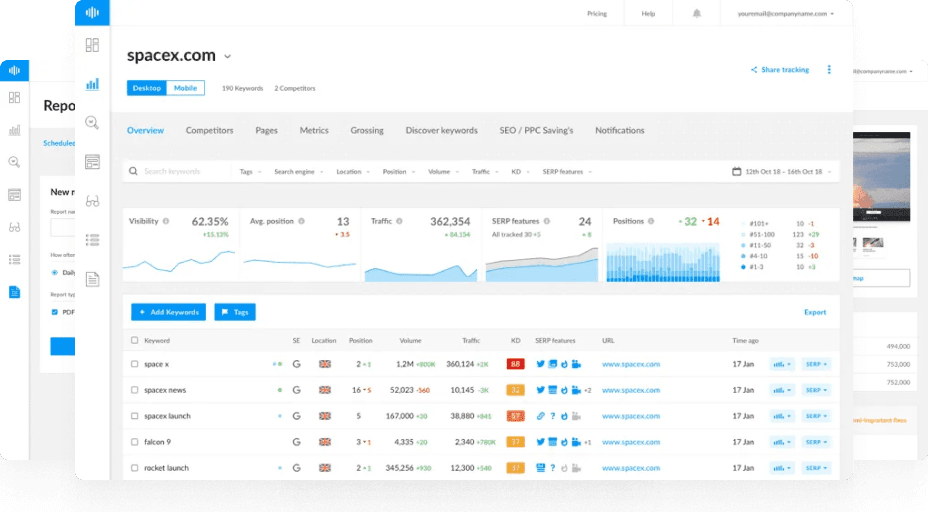What is RAG for SEO?
RAG for SEO (Retrieval-Augmented Generation for Search Engine Optimization) refers to optimizing your content and data for AI models that use retrieval mechanisms — such as Google Gemini, OpenAI GPT-4, Anthropic Claude, and Perplexity AI — to pull in real-time information from external sources before generating answers.
In traditional SEO, ranking is about being visible on SERPs.
In RAG-driven AI systems, the goal is to make your content retrievable, referenceable, and contextually reliable — so it becomes part of the factual layer AI uses to generate responses.
How RAG Works
RAG (Retrieval-Augmented Generation) blends two AI processes:
- Retrieval: The system searches external data sources (the web, APIs, or databases) to find the most relevant, recent information.
- Generation: It then uses an LLM (Large Language Model) to generate an answer that includes or summarizes the retrieved data.
This hybrid approach ensures accuracy, freshness, and traceability — allowing AI systems to reference real, up-to-date information instead of relying solely on their training data.
When applied to SEO, RAG means optimizing your content so AI systems:
- Can find it (retrieval-ready).
- Can understand it (semantically rich and structured).
- Can trust it (authoritative and verifiable).
Why RAG Matters for SEO
Generative AI is transforming search into answer engines that summarize the web rather than display a list of links.
RAG ensures your website remains visible within those summaries by becoming a trusted data source for AI retrieval systems.
1. Visibility in AI Responses
Content optimized for retrieval is more likely to appear or be cited within AI-generated answers — even if it doesn’t rank traditionally.
2. Real-Time Authority
RAG systems pull current data. Regular updates, freshness signals, and crawlable structure improve your likelihood of being retrieved.
3. Combatting AI Hallucinations
By providing structured, factual, and verifiable data, you help AI models replace hallucinated facts with your real information.
4. Competitive Differentiation
Early RAG optimization positions your site ahead of competitors as AI-integrated search engines evolve.
How to Optimize for RAG
1. Make Your Content Retrieval-Friendly
Ensure your pages are crawlable, indexable, and accessible to both search and AI crawlers. Avoid gated content or heavy JavaScript rendering that hides core information.
2. Use Structured Data
Implement schema markup (Article, Product, Organization, FAQPage) to help retrieval systems extract meaning. Include clear definitions and relationships for all entities.
3. Publish Factually Dense, Verifiable Content
RAG systems value content they can quote safely. Include:
- Verified facts
- Cited sources
- Data points
- Author credentials
The more verifiable your information, the more likely it will be retrieved.
4. Maintain Content Freshness
Because RAG depends on up-to-date information, publish recent updates and indicate freshness with timestamps, schema dateModified, and regular content revisions.
5. Focus on Semantic Coherence
Ensure your content is internally consistent and contextually complete. Embedding-based retrieval models rely on semantic relationships rather than keywords.
6. Optimize for Entities, Not Phrases
Use consistent entity names and structured relationships (e.g., linking “Ranktracker” to “SEO tools” and “SERP Checker”) so retrieval systems can map your data precisely.
7. Create Retrieval-Optimized APIs or Data Feeds
Consider offering machine-readable resources like CSVs, JSON endpoints, or datasets. These can be ingested directly into AI retrieval pipelines.
RAG for SEO vs Traditional SEO
| Feature | Traditional SEO | RAG for SEO |
|---|---|---|
| Goal | Rank in organic SERPs | Be retrieved and cited by AI systems |
| Data Model | Indexed pages | Vectorized semantic retrieval |
| Focus | Keywords, backlinks | Entities, factual density, structure |
| Update Cycle | Periodic crawls | Real-time retrieval |
| Visibility Metric | Rankings & CTR | Citations & inclusion in AI summaries |
Example of RAG in Action
Suppose a user asks an AI:
“What are the best SEO tracking tools for 2025?”
The AI model uses RAG to:
- Retrieve recent articles and tool reviews.
- Identify Ranktracker, Ahrefs, and Semrush as entities.
- Synthesize a summary mentioning Ranktracker’s Top 100 Tracking feature.
- Cite the original source page.
Because Ranktracker’s site uses structured data, updated information, and clear descriptions, it becomes an ideal retrieval target for the AI.
Technical Best Practices
- Use JSON-LD Schema to define all entities and attributes.
- Provide structured metadata (
title,description,author,dateModified). - Enable fast loading via Core Web Vitals (LCP, INP, CLS).
- Avoid render-blocking frameworks or JavaScript-only content.
- Use canonical URLs for consistency across citations.
- Implement Brotli compression and HTTP/3 for faster retrieval.
Tools Supporting RAG Optimization
- Ranktracker Web Audit: Identify indexability and structured data issues.
- Keyword Finder: Discover question-based queries aligned with generative search.
- SERP Checker: Monitor AI-augmented results for retrieval patterns.
- Backlink Checker: Strengthen authority signals for trusted inclusion.
The Future of RAG for SEO
As generative search evolves, RAG will define how AI models fetch and rank content. Future search will prioritize:
- Verified and structured information.
- Real-time updates and API-accessible data.
- Entities reconciled across Knowledge Graphs and embeddings.
Eventually, SEO, AEO, GEO, and RAG will merge into one unified discipline:
Optimizing for visibility in the AI layer of the web.
Summary
RAG for SEO ensures your content is retrievable, factual, and cited by the next generation of AI systems.
By blending traditional SEO fundamentals with semantic structure, freshness, and data transparency, you make your website a trusted retrieval source in the AI-driven future of search.
